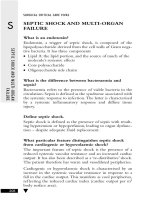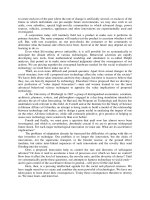Haemorrhagic Shock
Bạn đang xem bản rút gọn của tài liệu. Xem và tải ngay bản đầy đủ của tài liệu tại đây (179.15 KB, 15 trang )
SURGICAL CRITICAL CARE VIVAS
H
HAEMORRHAGIC SHOCK
᭢
119
HAEMORRHAGIC SHOCK
What is the definition of shock?
This is a syndrome of inadequacy of tissue perfusion to meet
the metabolic demands of the body and is associated with
the features of a sympathoadrenal and neuroendocrine
response.
What types of shock are there?
The types of shock may be classified as
᭹
Hypovolaemic
᭹
Cardiogenic
᭹
With reduced systemic vascular resistance
Septic shock: associated with gram negative organisms
Anaphylactic shock: associated with a type I
hypersensitivity reaction
Neurogenic shock: loss of sympathetic outf low
following spinal cord injury
᭹
With obstruction to blood f low
Massive pulmonary embolism
Cardiac tamponade
Give some causes of hypovolaemic shock.
᭹
Haemorrhage: which may be occult
᭹
Burns: following the loss of the protective epidermis
᭹
Dehydration:
Inadequate intake
Loss from the gut, e.g. vomiting, diarrhoea
Renal losses: diuretic abuse, osmotic diuresis of diabetic
ketoacidosis, Addisonian crisis
Give some common causes of acute occult bleeding
that can give rise to hypovolaemic shock.
᭹
Closed fractures of the femur or pelvis
᭹
Blunt chest trauma: injuring the heart, intercostal, internal
thoracic or great vessels
H
HAEMORRHAGIC SHOCK
SURGICAL CRITICAL CARE VIVAS
᭢
120
᭹
Blunt abdominal injury with bleeding from the liver or
splenic bed
᭹
Retroperitoneal bleed: may occur with ruptured
aneurysms
᭹
Obstetric haemorrhage: abruptio placenta, placenta
accreta, retained products
᭹
Post-operative exsanguination into a body cavity
How may the severity of blood loss be classified?
There are four classes depending on the volume lost
᭹
Class I: Ͻ500 ml (Ͻ10% of circulating volume)
᭹
Class II: 500–1000 ml (10–20% of circulating volume)
᭹
Class III: 1000–2000 ml (20–40%)
᭹
Class IV: Ͼ2000 ml (Ͼ40%)
How much blood may be lost from fractures of the
pelvis, femur and tibia?
᭹
Pelvic fractures, 1–3 l
᭹
Femoral fractures, 1–2 l
᭹
Tibial fractures, 0.5–1 l
Outline the cardiovascular response to blood loss.
The stimulus to the various responses to hypovolaemia comes
from a reduction of the venous return (preload) giving rise
to a fall in the cardiac output and arterial pressure, by the
Frank–Starling mechanism.
᭹
The baroreceptor ref lex stimulates sympathetic activity,
leading to a compensatory tachycardia, increased stroke
volume with peripheral vaso- and venoconstriction
᭹
This has the effect of increasing the cardiac output
᭹
Pain and injury also stimulates catecholamine release from
the adrenal medulla – particularly norepinephrine, which
increases the peripheral vascular resistance
᭹
Release of corticosteroids from the adrenal cortex
stimulates salt and water retention and stimulates the
systemic stress response
SURGICAL CRITICAL CARE VIVAS
H
HAEMORRHAGIC SHOCK
᭢
121
᭹
In the medium term, the reduction in the circulating
volume and increased sympathetic activity stimulates the
release of renin from the macula densa of the juxta-
glomerular apparatus of the kidney. This leads to the
renin-angiotensin-aldosterone cascade. There is salt and
water retention, helping to restore the circulating volume
over the next few hours
᭹
Reduction of renal perfusion stimulates erythropoetin
production, and thus erythropoesis
What are the clinical features of haemorrhagic shock?
Clinical features depend on the volume of blood loss, and the
degree of compensation. Features include
᭹
Tachycardia
᭹
Initial normal blood pressure with a narrowed pulse
pressure
᭹
Cool peripheries: a sign of redistribution of blood to
more important organ systems
᭹
Reduced CVP, with a transient, unsustained rise following
f luid challenge
᭹
Reduced urine output
᭹
Confusion: due to reduced cerebral perfusion
What features are seen as the patient
decompensates?
᭹
Reduction of the level of consciousness
᭹
Falling arterial pressure
᭹
Worsening lactic acidosis: consequent upon a sustained
poor peripheral perfusion stimulating anaerobic
metabolism
᭹
Bradycardia
Why do decompensating patients often become
bradycardic?
Bradycardia may arise from a number of factors
᭹
Stimulation of the ‘depressor ref lex’: deformation of the
ventricular wall occurring as a result of poor ventricular
H
HAEMORRHAGIC SHOCK
SURGICAL CRITICAL CARE VIVAS
᭢
122
filling leads to activation of vagal C-fibre afferents in the
myocardium. This leads to increased vagal activity,
manifesting as bradycardia associated with blood loss. It is
thought that this ref lex has the protective effect of
reducing the myocardial oxygen demand when the
coronary perfusion is poor, at the expense of causing
decompensation
᭹
Myocardial activity may be impaired by persisting
ischaemia
Define the haematocrit (packed cell volume).
What is the normal level?
This is the proportion of the total blood volume that consists
of the red cells. It may be expressed as a percentage or a
fraction of the blood volume. It is 0.4–0.54 in males, and
0.37–0.47 in females.
What factors determine the haematocrit?
This is determined by
᭹
Changes in the total red cell volume: e.g. due to blood
loss
᭹
Changes in the plasma volume: e.g. losses of water, or
plasma expansion that occurs in pregnancy or f luid
overload
᭹
Sex of the individual – being greater in men
᭹
Venous or arterial blood: The volume of red cells in
venous blood is slightly higher than in arterial blood
due to entry of water with chloride ions during the
chloride shift that occurs with CO
2
-carriage.
Therefore, the packed cell volume in venous blood is
higher
What are the consequences of a change in the
haematocrit?
The implications are
᭹
Alterations in the oxygen-carrying capacity of the blood
᭹
Changes in the viscosity of the blood, which affect the
rate and pattern of blood f low in the vascular tree
SURGICAL CRITICAL CARE VIVAS
H
HAEMORRHAGIC SHOCK
123
How can the blood volume be calculated from the
plasma volume?
What is the basic management of blood loss?
The basic management involves
᭹
Gaining adequate vascular access. The Hagen–Poiseuille
equation states that f luid f low through a tube is
proportional to the fourth power of the radius of the
tube, and inversely proportional to its length. Thus, the
most immediately useful form of access is a wide-bore
peripheral cannula, not a central line
᭹
Supporting the arterial pressure with a f luid infusion to
improve the venous return. Pneumatic anti-shock
trousers have also been used to improve the venous
return
᭹
Crystalloids and colloids may help to increase the blood
pressure, and therefore improve peripheral organ
perfusion. However, they do not improve the oxygen
carrying capacity of the blood – only a blood transfusion
may do this. Therefore, a transfusion is organised in more
severe cases of blood loss
᭹
The success of resuscitation can be assessed with the aid
of a urinary catheter to measure the urine output, and a
central line to assess cardiac filling
᭹
If there is an open site of bleeding, it may be controlled
by digital pressure
᭹
Ultimately, following initial recitation and stabilisation,
surgical intervention may be required to stem further loss
of blood, e.g. laparotomy, thoracotomy, fracture
immobilisation
᭹
Note that, in the case of trauma, all of this should be
performed in the context of the ABCD of the primary
survey during C-spine control
×
−
100
Blood volume = plasma volume
100 haematocrit
H
HEAD INJURY I – PHYSIOLOGY
SURGICAL CRITICAL CARE VIVAS
᭢
124
HEAD INJURY I – PHYSIOLOGY
What is the volume of the cerebrospinal fluid (CSF)?
140–150 ml.
Where is CSF produced, and at what rate?
70% of CSF is produced by the choroid plexus of the lateral,
third and fourth ventricles. 30% comes directly from the
vessels lining the ventricular walls. It is produced at a rate of
0.35 ml/min, or ~500 ml/day.
Briefly describe the circulation of CSF.
From the lateral ventricle, the CSF f lows into the third ven-
tricle through the interventricular foramen of Monro. From
here it enters into the fourth ventricle through the aqueduct of
Sylvius. Some continue down into the central canal of the
spinal cord, but the majority f low into the sub-arachnoid space
of the spinal cord via the central foramen of Magendie, or the
two lateral foramina of Luschka. After going around the spinal
cord, it enters the cranial cavity through the foramen magnum,
and f lows around the brain within the sub-arachnoid space.
What are the arachnoid villi composed of?
The arachnoid villi are formed from a fusion of arachnoid
membrane and the endothelium of the dural venous sinus
that it has bulged into.
Where is the CSF finally absorbed?
80% of CSF is absorbed at the arachnoid villi, and 20% is
absorbed at the spinal nerve roots.
What structures form the blood-brain barrier (BBB)?
The BBB, which is a histological and physiological boundary
between the blood and the CSF, is formed from two types of
special anatomical arrangement
᭹
Tight junctions in-between the endothelial cells of the
cerebral capillaries









